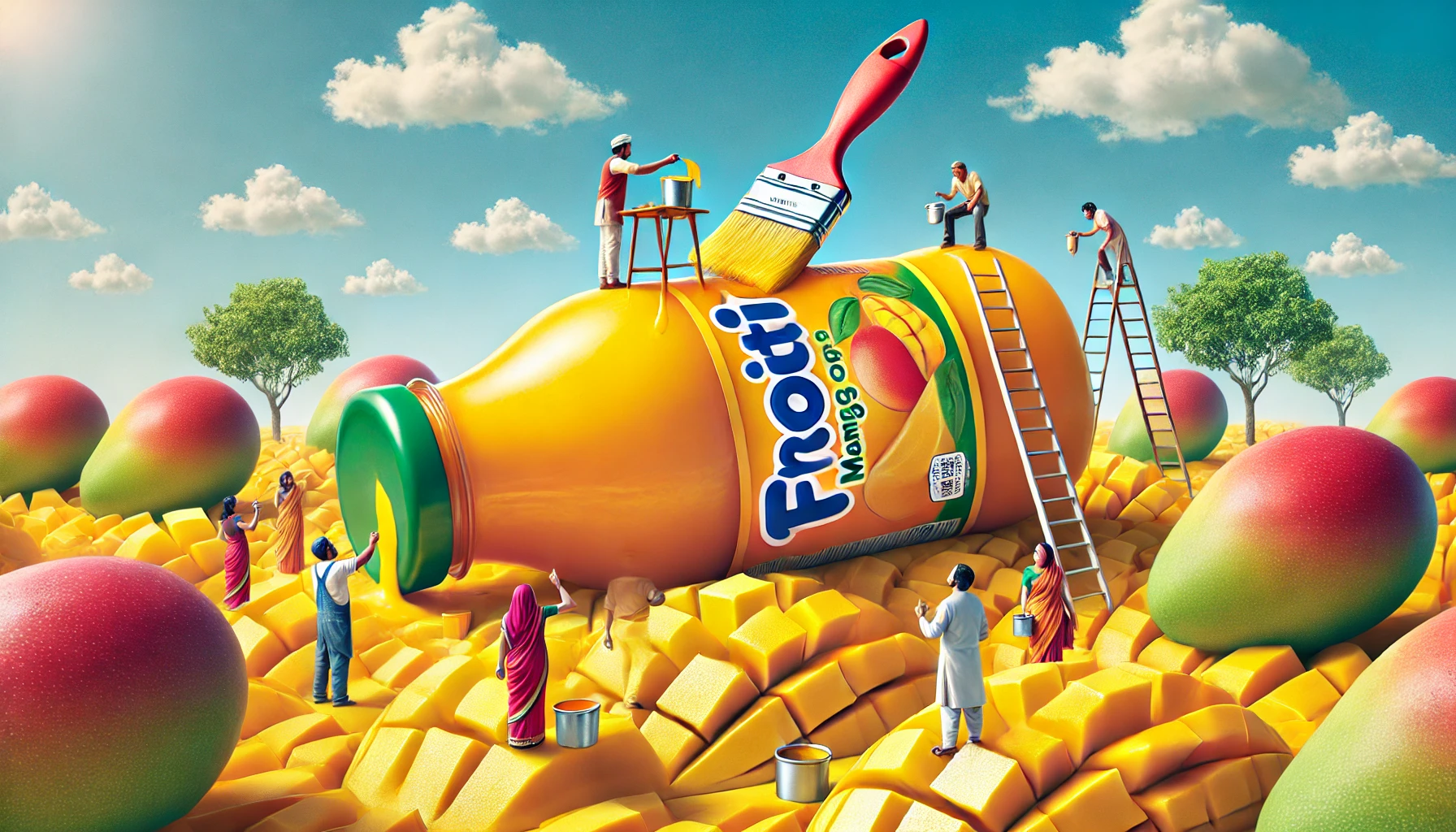“Mango fruity, fresh and juicy” – catch yourself humming that tune or silently mouthing the words? Either way, Frooti has managed to worm its way into our hearts. Who hasn’t begged for that last sip of a Frooti, strategically placed an empty bottle in the fridge hoping for a refill or pleaded the neighbourhood shopkeeper for a “10 wali Frooti”? From sharing secrets to cooling down after a game, Frooti is the taste of your childhood captured in a bottle.
Frooti is more than just a mango drink; it’s a part of our childhood. From birthday bashes to scorching summer days, its bubbly mango magic always hits the spot. It’s a nostalgia, a reminder of carefree days and simple joys.
Fast forward to today, and Frooti is still a national obsession. But how did a simple mango drink turned into a Rs 4000 crore empire? Did they really just squeeze a mango and watch billions roll in? Let’s peel back the layers and uncover the secrets behind Frooti’s incredible success.
Introduction
Frooti, the iconic mango drink, is one of India’s most beloved beverages. It has become a staple in households across the country, known for its unique flavor and playful branding. But how did Frooti evolve from a simple mango drink to a Rs 4000 crore brand? This case study delves into the strategic decisions and innovative approaches that transformed Frooti into a market leader.
The Great Parle Divide
Frooti is a product of Parle Agro Limited, a company that is often confused with the makers of Parle-G biscuits or Bisleri water. However, these three entities are separate businesses owned by different members of the Chauhan family. Founded in 1929 by Mohanlal Chauhan, the Parle Group embarked on its journey as a modest bakery in Vile Parle, Mumbai. Over the decades, the company expanded its horizons, venturing into diverse food and beverage segments.
In 1939, Parle achieved a significant breakthrough with the launch of Parle Gluco biscuits and Monaco, which were initially supplied to the British Army. After India gained independence in 1947, Parle embraced the Swadeshi movement, leading to widespread adoption of its products. This laid the foundation for Parle to become a global brand.
In 1977, the Indian government banned multinational companies like IBM and Coca-Cola, which in turn opened up the soft drink market to Indian manufacturers. This led to the creation of popular drinks like Limca and Thums Up by Parle.
Among the five Chauhan brothers, Jayantilal Chauhan, the youngest, wanted to establish his own venture which lead to the birth of Parle Agro Limited. Meanwhile, another brother, Ramesh Chauhan, took charge of Bisleri. Thus, the Parle Group branched into three distinct companies:
- Parle Products – Known for biscuits and toffees like Parle-G, Monaco, and Kismi.
- Parle Bisleri – Famous for Bisleri water.
- Parle Agro – Producer of Frooti, Appy, Appy Fizz, BFizz, SMOODH, Bailley drinking water, Bailley Soda and Bombay 99.

The History of Frooti
In 1984, Parle Agro recognized an opportunity in the Indian beverage market, which was dominated by carbonated drinks. Back in the day, fruit juices were all about fresh, on-the-spot squeezing. It created a gap for a convenient, packaged mango drink in the market. The market was ripe for a ready-to-drink revolution. That’s where Frooti stepped in.
Frooti’s entry into the market was revolutionary. It was the first drink in India to be sold in a tetra pack, a packaging innovation that made it easy to carry, store, and enjoy on the go. This convenience, coupled with India’s love for mangoes, made Frooti an instant success.
Parle Agro’s marketing strategy further solidified Frooti’s place in the market. The brand was positioned as a drink for everyone, with a special focus on children. The bright, playful branding, catchy jingles, and association with fun moments helped Frooti build a strong emotional connection with consumers.
DID YOU KNOW?
Frooti was one of the first drinks in India to be sold in a tetra pack, a game-changing innovation that played a major role in its success!
Strategic Growth and Diversification
Despite its initial success, Frooti faced challenges as competitors like Real, Maaza and Slice entered the market. By 2002, Frooti’s revenues had plateaued around Rs 300 crores. It was clear that the brand needed to innovate and diversify to sustain growth.
In 2003, Nadia Chauhan, the daughter of Jayantilal Chauhan, joined Parle Agro at the young age of 17. Tasked with handling the marketing and strategy for the brand, she swiftly became the driving force behind the iconic brand’s evolution. Nadia introduced several key changes that propelled Frooti to new heights.
Her first major move was diversification, leading to the creation of Appy Fizz, a sparkling apple drink that tapped into a new segment of the market. This reduced the company’s reliance on Frooti, which at the time contributed to 95% of total revenues.
Nadia then turned her focus to Frooti, initiating a rebranding effort. The brand’s initial attempt at a new look was a bit of a head-scratcher. London-based design firm, Pentagram, gave Frooti a surprising makeover. Instead of the brand’s usual playful image, they opted for a bold, almost militaristic look. The new logo featured a stencil-like font, inspired by the typography found on mango crates. While there was an attempt to add a playful touch with a slight slant, the overall design felt more like someone had replaced the friendly neighborhood ice cream man with a drill sergeant.

Enters Sagmeister & Walsh – a New York-based agency, who were tasked with transforming the serious Frooti back into the playful, refreshing drink we all know and love. They approached the challenge with a refreshing dose of creativity. Instead of trying to soften the harsh lines of the logo, they decided to embrace it and create a world around it.
By placing the Frooti pack in miniature settings filled with bright colors and playful characters, they managed to bring back a sense of fun and wonder into the brand. It was like taking a serious, grown-up toy and placing it in a magical, childlike world. The contrast between the bold, military-inspired logo and the playful surroundings created a unique and memorable visual identity of the brand. This shift helped reposition Frooti from a children’s drink to a more versatile product for youth.

If Nadia Chauhan could transform a brand at just 17, what’s holding you back from launching your own business? Whether you’re brainstorming ideas or wondering which venture will bring in the most profit, don’t let indecision keep you from success. Dive into our blog on the Best Sectors to Start a Successful Business in 2024 and explore 21 of the Best Online Business Ideas for 2024. Your next big opportunity is just a click away!
How Frooti Conquered Shelves and Hearts?
One of the most significant innovations under Nadia’s leadership was the introduction of the “samosa pack” in 2004, priced at just Rs 2.50. This triangular packaging was inspired by hawkers selling peanuts for Rs 2 and was designed to get the attention of consumers in rural areas. The affordable price point made Frooti accessible to a wider audience, including children in urban areas who could purchase the drink with their pocket money.
This strategy resulted in increased consumption and a broader customer base. To broaden Frooti’s consumer base, the brand made a strategic move by hiring Bollywood superstar Shah Rukh Khan as its brand ambassador. This partnership marked a shift in target audience, extending Frooti’s appeal beyond its traditional youth demographic to adult audience.
Frooti continued to evolve, with a complete brand revamp that included a new logo, design, and packaging. The new logo was inspired by the lettering on crates used to deliver Totapari mangoes, which was the key ingredient of Frooti.
The strategic changes implemented by Nadia Chauhan transformed Frooti from a Rs 300 crore brand to a Rs 4000 crore powerhouse. The brand’s innovative packaging, targeted marketing, and successful diversification into new products like Appy Fizz ensured its place as a market leader in the Indian beverage industry.
Frooti’s SWOT and Competitive Analysis
Strengths of Frooti
Frooti, a brand synonymous with mango juice, has long been a dominant player in the Indian beverage market. Parle Agro’s innovative approach to creating an on-the-go drink helped Frooti carve out a niche that few competitors could rival.
- Strong Brand Legacy: From the beginning, Frooti has been a product of branded success, widely recognized for its vibrant and youthful image. It’s a name that evokes nostalgia, particularly among those who grew up in the ’90s.
- Innovative Packaging: Frooti’s tetra pack was a game changer, making it convenient and accessible to a broad audience. This clever packaging was not only easy to carry but also preserved the fresh mango flavor, contributing significantly to its popularity.
- Extensive Distribution Network: Backed by Parle Agro’s robust distribution network, Frooti has a presence in both urban and rural markets. Its reach is unparalleled, ensuring that the drink is available across the country, whether in supermarkets or local kirana stores.
- Adapting to Market Trends: Frooti was the first Indian brand to introduce a non-carbonated soft drink (NCSD) in a tetra pack, and it has continued to innovate, expanding into new flavors and product lines while maintaining its core identity.
Weaknesses of Frooti
Despite its many strengths, Frooti faces several challenges that have hindered its growth.
- Limited Flavor Range: Frooti’s focus on mango flavor has made it a one-dimensional brand in a market where consumers are increasingly seeking variety. Competitors have successfully diversified their product lines with a range of fruit flavors.
- Health Perception: While Frooti contains Vitamin A, it is not widely regarded as a healthy drink. The brand is often perceived as a drink for children, which limits its appeal to health-conscious adults.
- Failed Product Extensions: Parle Agro’s attempt to diversify with products like Frooti Fizz and variations like pineapple fizz did not resonate well with consumers, leading to stagnation in sales.
- Environmental Concerns: With the increasing awareness of plastic pollution, Frooti’s reliance on single-use packaging is becoming a significant drawback. The brand will need to innovate in this area to align with growing consumer demand for sustainability.
Opportunities for Frooti
Frooti has several opportunities to leverage for growth in an evolving market.
- Healthier Product Lines: With consumers becoming more health-conscious, there is a growing market for beverages that are both tasty and nutritious. Frooti can capitalize on this by introducing healthier variants or fortifying its current offerings.
- Expansion into New Flavors: The demand for diverse flavors in fruit juices is growing. Frooti can introduce new variants to cater to these tastes while maintaining its stronghold in the mango segment.
- Urban Market Growth: As India’s urban population continues to grow, there is a rising demand for packaged beverages. Frooti’s established distribution network can help it tap into this expanding market.
- Untapped Rural Markets: While Frooti has a significant presence in rural areas, there is still room for growth. By introducing more affordable packaging and marketing tailored to rural consumers, Frooti can expand its reach.
Threats to Frooti
The competitive landscape poses several threats to Frooti’s market position.
- Intense Competition: The juice sector is fiercely competitive, with major players like Tropicana, Real, Maaza, and Slice vying for market share. These brands are continuously innovating, making it difficult for Frooti to maintain its dominance.
- Changing Consumer Preferences: As consumers become more health-conscious, there is a shift towards beverages perceived as healthier, which could impact Frooti’s sales.
- Regulatory Challenges: Frooti has faced controversies related to food safety and compliance with regulations, which have tarnished its reputation in the past. Any future missteps could further damage the brand.
- Unorganized Market: The rise of unorganized players offering fresh juices presents a significant threat. These local vendors can offer a product perceived as fresher and healthier, which appeals to a growing segment of consumers.
Competitive Analysis of Frooti
Frooti operates in a highly competitive market, particularly within the non-carbonated mango-flavored segment. Its primary competitors, Maaza and Slice, have substantial market shares of 43% and 26%, respectively.
- Strength in Simplicity: While Frooti has stuck to its core mango flavor, competitors have diversified, offering a range of fruit-based drinks. However, Frooti’s strong brand identity has allowed it to maintain a leading position.
- Market Position: Frooti has positioned itself as an affordable and accessible mango drink, appealing to a broad demographic. This strategy has helped it stay relevant, even as competition has intensified.
- Future Growth: To outmaneuver its competitors, Frooti could explore new segments by introducing more flavors and healthier options, thus appealing to the evolving tastes of Indian consumers.
Final Wrap-Up
Frooti’s journey offers several valuable lessons for businesses:
- Innovation as a Growth Driver: Constant innovation in product development and packaging can significantly enhance a brand’s market presence and consumer appeal.
- Navigating Competitive Markets: Staying ahead in a competitive market requires continuous innovation, strategic positioning, and a deep understanding of competitors’ strengths and weaknesses.
- Challenges of Product Extensions: Not all product extensions succeed; careful market analysis and understanding consumer needs are essential before launching new products.
- Importance of Diversification: Diversifying product lines can mitigate risk by reducing reliance on a single product, while also tapping into new and emerging market segments.
- Rebranding and Adaptation: Regularly adapting a brand’s image and offerings in response to market trends and consumer preferences is crucial for maintaining relevance and competitive edge.









